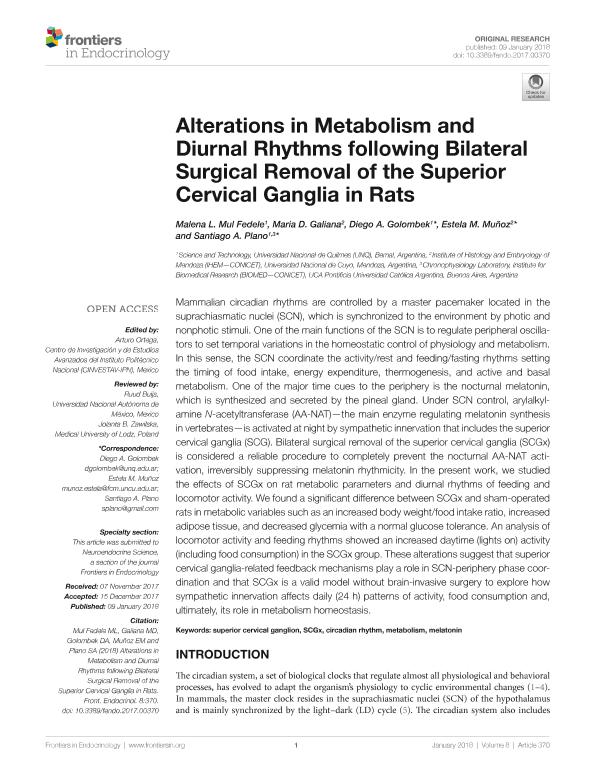Mostrar el registro sencillo del ítem
dc.contributor.author
Mul Fedele, Malena Lis

dc.contributor.author
Galiana, Maria D.
dc.contributor.author
Golombek, Diego Andrés

dc.contributor.author
Muñoz, Estela Maris

dc.contributor.author
Plano, Santiago Andrés

dc.date.available
2020-01-02T17:33:22Z
dc.date.issued
2018-01
dc.identifier.citation
Mul Fedele, Malena Lis; Galiana, Maria D.; Golombek, Diego Andrés; Muñoz, Estela Maris; Plano, Santiago Andrés; Alterations in Metabolism and Diurnal Rhythms following Bilateral Surgical Removal of the Superior Cervical Ganglia in Rats; Frontiers Media SA; Frontiers in Endocrinology; 8; 1-2018; 1-10
dc.identifier.issn
1664-2392
dc.identifier.uri
http://hdl.handle.net/11336/93290
dc.description.abstract
Mammalian circadian rhythms are controlled by a master pacemaker located in the suprachiasmatic nuclei (SCN), which is synchronized to the environment by photic and nonphotic stimuli. One of the main functions of the SCN is to regulate peripheral oscillators to set temporal variations in the homeostatic control of physiology and metabolism. In this sense, the SCN coordinate the activity/rest and feeding/fasting rhythms setting the timing of food intake, energy expenditure, thermogenesis, and active and basal metabolism. One of the major time cues to the periphery is the nocturnal melatonin, which is synthesized and secreted by the pineal gland. Under SCN control, arylalkylamine N-acetyltransferase (AA-NAT)-the main enzyme regulating melatonin synthesis in vertebrates-is activated at night by sympathetic innervation that includes the superior cervical ganglia (SCG). Bilateral surgical removal of the superior cervical ganglia (SCGx) is considered a reliable procedure to completely prevent the nocturnal AA-NAT activation, irreversibly suppressing melatonin rhythmicity. In the present work, we studied the effects of SCGx on rat metabolic parameters and diurnal rhythms of feeding and locomotor activity. We found a significant difference between SCGx and sham-operated rats in metabolic variables such as an increased body weight/food intake ratio, increased adipose tissue, and decreased glycemia with a normal glucose tolerance. An analysis of locomotor activity and feeding rhythms showed an increased daytime (lights on) activity (including food consumption) in the SCGx group. These alterations suggest that superior cervical ganglia-related feedback mechanisms play a role in SCN-periphery phase coordination and that SCGx is a valid model without brain-invasive surgery to explore how sympathetic innervation affects daily (24 h) patterns of activity, food consumption and, ultimately, its role in metabolism homeostasis.
dc.format
application/pdf
dc.language.iso
eng
dc.publisher
Frontiers Media SA

dc.rights
info:eu-repo/semantics/openAccess
dc.rights.uri
https://creativecommons.org/licenses/by-nc-sa/2.5/ar/
dc.subject
CIRCADIAN RHYTHM
dc.subject
MELATONIN
dc.subject
METABOLISM
dc.subject
SCGX
dc.subject
SUPERIOR CERVICAL GANGLION
dc.subject.classification
Biología

dc.subject.classification
Ciencias Biológicas

dc.subject.classification
CIENCIAS NATURALES Y EXACTAS

dc.subject.classification
Biología

dc.subject.classification
Ciencias Biológicas

dc.subject.classification
CIENCIAS NATURALES Y EXACTAS

dc.title
Alterations in Metabolism and Diurnal Rhythms following Bilateral Surgical Removal of the Superior Cervical Ganglia in Rats
dc.type
info:eu-repo/semantics/article
dc.type
info:ar-repo/semantics/artículo
dc.type
info:eu-repo/semantics/publishedVersion
dc.date.updated
2019-10-21T20:07:11Z
dc.journal.volume
8
dc.journal.pagination
1-10
dc.journal.pais
Suiza

dc.description.fil
Fil: Mul Fedele, Malena Lis. Consejo Nacional de Investigaciones Científicas y Técnicas; Argentina. Universidad Nacional de Quilmes. Departamento de Ciencia y Tecnología; Argentina
dc.description.fil
Fil: Galiana, Maria D.. Consejo Nacional de Investigaciones Científicas y Técnicas; Argentina. Universidad Nacional de Cuyo. Facultad de Ciencias Médicas. Instituto de Histología y Embriología; Argentina
dc.description.fil
Fil: Golombek, Diego Andrés. Universidad Nacional de Quilmes. Departamento de Ciencia y Tecnología; Argentina. Consejo Nacional de Investigaciones Científicas y Técnicas; Argentina
dc.description.fil
Fil: Muñoz, Estela Maris. Universidad Nacional de Cuyo. Facultad de Ciencias Médicas. Instituto de Histología y Embriología; Argentina. Consejo Nacional de Investigaciones Científicas y Técnicas; Argentina
dc.description.fil
Fil: Plano, Santiago Andrés. Universidad Nacional de Quilmes. Departamento de Ciencia y Tecnología; Argentina. Pontificia Universidad Católica Argentina "Santa María de los Buenos Aires". Instituto de Investigaciones Biomédicas. Consejo Nacional de Investigaciones Científicas y Técnicas. Oficina de Coordinación Administrativa Houssay. Instituto de Investigaciones Biomédicas; Argentina
dc.journal.title
Frontiers in Endocrinology
dc.relation.alternativeid
info:eu-repo/semantics/altIdentifier/url/http://journal.frontiersin.org/article/10.3389/fendo.2017.00370/full
dc.relation.alternativeid
info:eu-repo/semantics/altIdentifier/doi/http://dx.doi.org/10.3389/fendo.2017.00370
Archivos asociados
